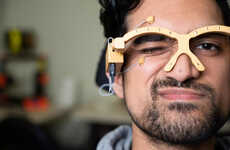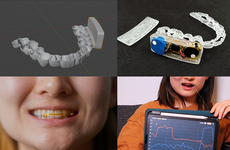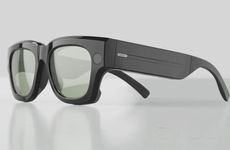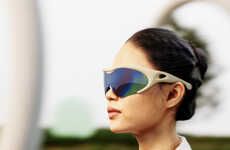
These 3D-Printed Glasses Monitor Use of the Chewing Muscles
Laura McQuarrie — June 30, 2016 — Lifestyle
References: bsn.embs.org & 3ders.org
These 3D-printed glasses are interesting for reasons that go beyond being created with additive manufacturing. Researchers from the University of Passau created these 'Diet Eyeglasses' as a way to help people lose weight and eat healthier.
These glasses are part of the WISEglass project, which is centered around smart eyewear systems. Although they don't look it, the 3D-printed glasses are embedded with technology and electromyography sensors that touch the area directly behind the ears. The spot where the arms of the glasses touch the skin are able to pick up on contractions of the facial muscles that are used during chewing.
The smart glasses are able to differentiate between different kinds of movements, including coughing, drinking water and speaking, as well as foods of different textures like bananas and cookies. This data helps to inform what kind of a diet the wearer has and holds them accountable for everything they eat.
These glasses are part of the WISEglass project, which is centered around smart eyewear systems. Although they don't look it, the 3D-printed glasses are embedded with technology and electromyography sensors that touch the area directly behind the ears. The spot where the arms of the glasses touch the skin are able to pick up on contractions of the facial muscles that are used during chewing.
The smart glasses are able to differentiate between different kinds of movements, including coughing, drinking water and speaking, as well as foods of different textures like bananas and cookies. This data helps to inform what kind of a diet the wearer has and holds them accountable for everything they eat.
Trend Themes
1. Smart Eyewear Systems - The development of smart eyewear systems has created disruptive innovation opportunities in the health and wellness industry.
2. Additive Manufacturing for Wearable Technology - The use of additive manufacturing for wearable technology is creating opportunities for innovation in the manufacturing and fashion industries.
3. Facial Muscle Sensing Sensors - The integration of facial muscle sensing sensors in wearable technology has the potential to disrupt the healthcare and fitness industries.
Industry Implications
1. Health and Wellness - The integration of smart eyewear systems and facial muscle sensing sensors in wearable technology has the potential to disrupt the health and wellness industry.
2. Manufacturing - The use of additive manufacturing for wearable technology is creating disruptive innovation opportunities in the manufacturing industry.
3. Fashion - The use of additive manufacturing for wearable technology has the potential to disrupt the fashion industry by creating new, customizable products.
2.9
Score
Popularity
Activity
Freshness























